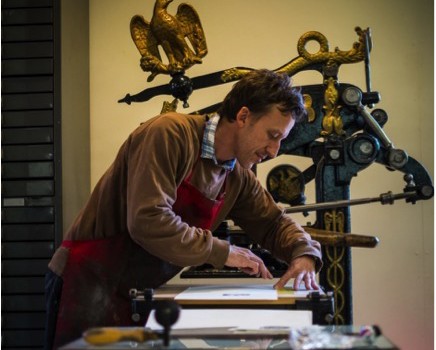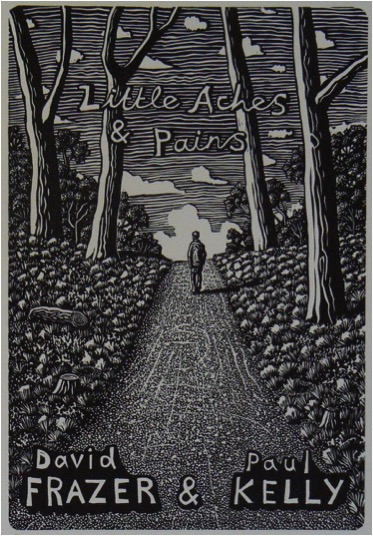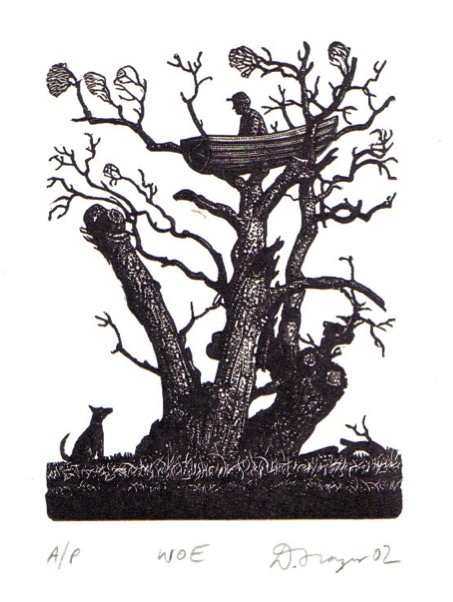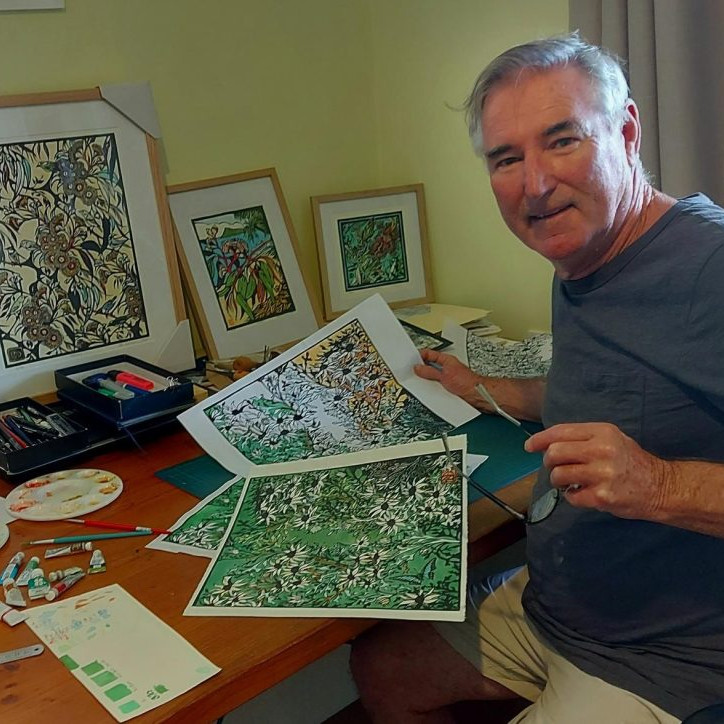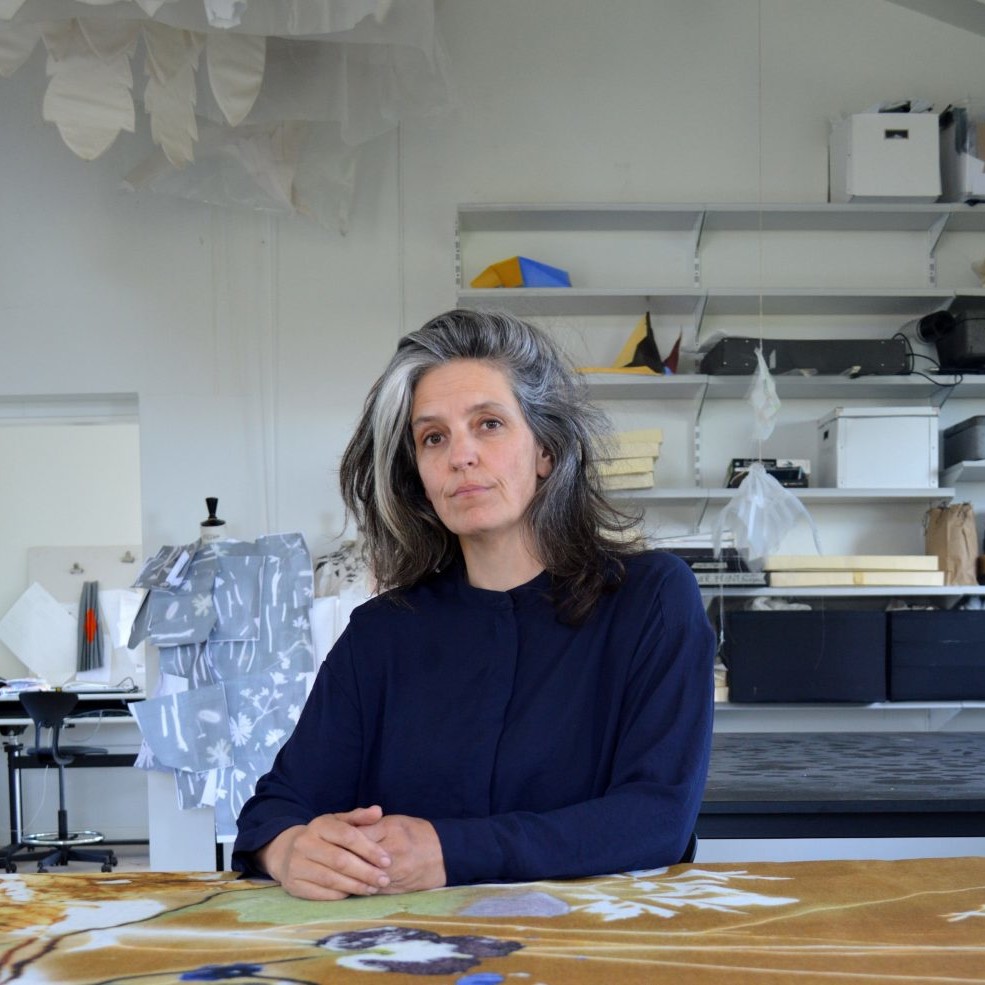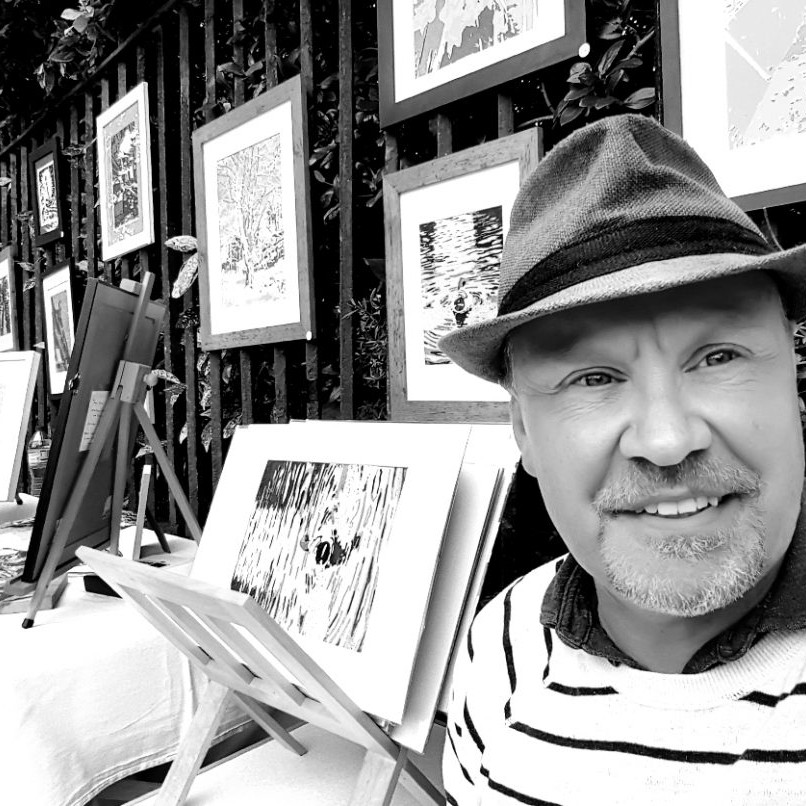David Frazer Printmaker - Victoria, Australia.
You have always wanted to be a songwriter, but realized that you were more suited to Printmaking. Discuss this in relation to you comment. “I think of my work like a songwriter would produce an album”?
I wanted to be famous due I suspect to insecurity, I wanted to be popular and adored like Elvis, ha ha. I wanted to write beautiful heart felt songs and move people to tears. I really wanted to connect with people; I probably found it hard to do that the normal way. Anyway I tried song writing but couldn’t do it, I became an occasionally funny karaoke act. After art school I had discovered printmaking and found it more suitable than painting. When I saw reason and quit showbiz I decided to get back into art and focus on printmaking. I went back to art school to do an honours years in printmaking. There I discovered wood engraving and found it to be as close to song writing than any other medium. It suited poetry, narrative and storytelling. I also found I could do a series of engravings, even had some text and bind them into a book. Also what I discovered was that suddenly I had a subject. My years of trying and failing in the world of showbiz gave me that. Topics of yearning and alienation, failed ambition etc. still form the basis of my work. I’d won half the battle.
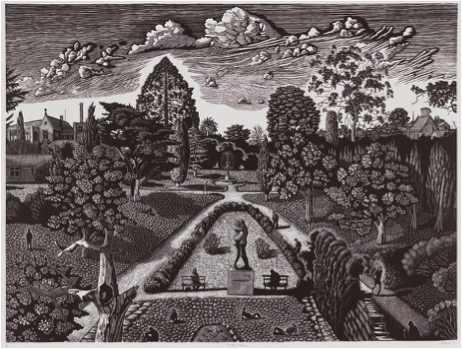
Together Alone’
You have also worked in collaboration with songwriter, Paul Kelly please expand on this and the book ‘Little Aches and Pains’?
It wasn’t really a collaboration, as Paul said when opening the launch of the book, all he did was say yes. I used the lyrics to a song he had already written for his most recent album “spring and fall”. I just found it refreshing to use someone else’s words to interpret. I also felt an affinity to the theme of a frustrated guy reminiscing about an old love or friendship that went wrong and wondering how life could have turned out different. I love the beauty in sadness and human frailty.
You have a strong formal arts background, though it has not always followed in the school – study – work pattern. Can you discuss this?
I’m not sure I understand the question. I also dispute that I had a strong formal arts background. Sure I’ve got a few letters after my name but any idiot could have got them. I learnt practically nothing in art school. I could have in first year where I was at Caulfield tech (now Monash) but I was an idiot and didn’t think I needed to learn technique. I then stupidly went to Phillip institute which was a complete waste of time. I learnt a bit back at Monash when I did my honours years. At that time there was a lot of practising printmakers there and I learnt a lot then. I stayed on there for ten year employed as a part time tech where I learnt a bit. During that time I did a masters and got a scholarship, not sure how much I got out of that but I suppose it did help me formalise my themes and approach a bit. About ten years ago I worked as an edition printer for port Jackson press and I learnt a lot there about printing. Still, I don’t exactly feel like an expert in printmaking; maybe that’s a good thing?
How do you decide on the medium you will use, eg paint, sculpture, engravings?
I’m pretty much focusing now on graphics. I struggled for years trying to paint and it felt like an exercise in torture and for all that time and effort I had a pretty small success rate. I settled on using the paintings as the scenic art, the stage for my characters and narrative that I portrayed with my prints. Seemed like a good system but in the end I just got sick of the struggle to paint. To be a good painter you have to be obsessed with paint and you have to work really hard at it, and want to. You have to be interested in aesthetics, with colour, with how you apply the paint etc. and I really didn’t give a rat’s arse about any of those things. I am only interested in the narrative really and I figured I was kidding myself trying to be a painter.
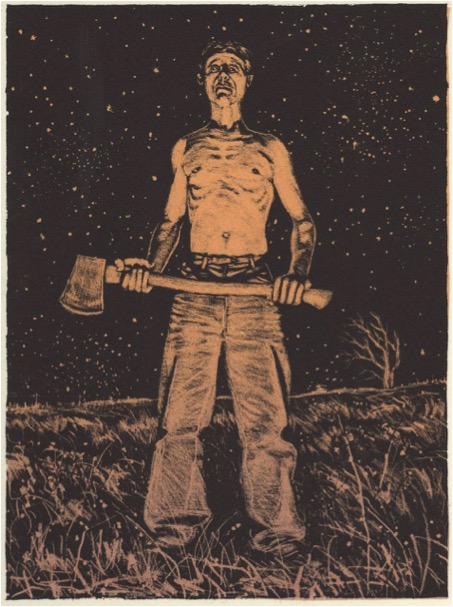
‘Skinny Man with an Axe’
Please discuss the size of your work and what the restrictions are?
Most of my prints have been small. Wood engravings are usually small due to the nature of the end grain boxwood. The smallness gives the work an intimacy, it forces people to go up close to the work and take in the detail, and maybe the poetry or narrative. I recently have started doing large scale linocuts which end up looking like huge wood engravings and provide quite an impact! It’s actually become an exciting development for me and the first big one I did “waiting for rain” sold out the edition of 50 in a year and gave me more money than I ever would have got for a painting that size. The down side is that they take ages to do. That work took me 3 months to cut, and it’s really tedious monotonous work! Still, I’d take boredom any day over the emotional torture of trying to paint! Also, I find it quite easy and I have a confidence that I never got with painting. That actually tells you something; but sometimes it takes a while for the penny to drop.

‘Another night on Earth’
In 2007 you took part in the International Print Biennale in Guanlan, China, where you became a major prize winner. How did this influence your career?
It gave me the confidence to know that my prints were technically good (at least sometimes). It was a real confidence boost getting that acknowledgement on an international stage where no one knew me from a bar of soap. I’ve been back regularly since for other biennials and artist in residencies. They think I’m a world famous artist and it’s nice to be treated like royalty once in a while. The last time I was there I was giving a show and I even got a billboard on the street, you don’t get that every day! Also it was good not only getting to meet other international artists and seeing their work but also seeing what the Chinese printmakers are doing. It was their big wood cuts that inspired me to try large scale linocuts.
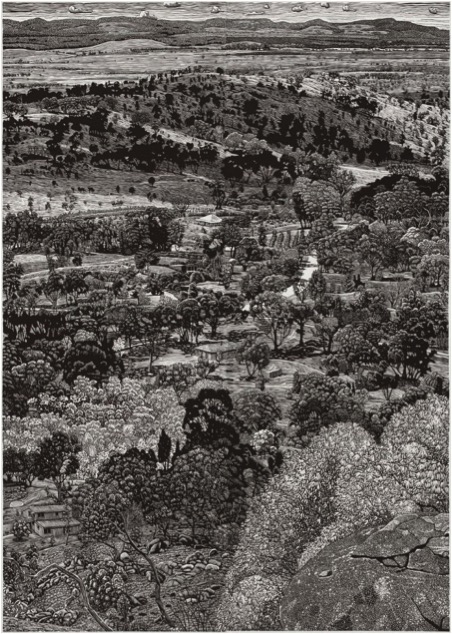
‘Waiting for Rain’
Let’s discuss your prints:
The number of editions you make?
I used to do small editions but it’s really annoying when they prove popular and you don’t have enough to sell so now I do at least 50-70. I got to make a living.
What you do with the plates after the print run?
Sometimes I take my old copper plates to the metal yard as you get good money for copper now. I usually keep my wood blocks, sometimes I get them resurfaced so I can use them again. I’ll probably donate the blocks from my Paul Kelly book to the state library of Victoria.
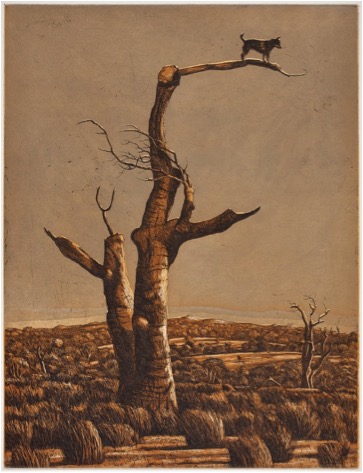
‘Lost Dog’
Your work is mainly about place. Can you discuss this common thread?
I love the duality of loving a place but wanting to escape it. I grew up in country Victoria, son of the school principal and a blow in (I’ve always been a blow in). The Wimmera where I lived in my primary school years is flat, with a certain melancholic beauty. It seeped into my system somehow and that landscape became the setting for my art. That environment though can be stifling and I used that to expand on the desires to escape it, to be somewhere more exciting and to be someone more exciting. Also I love the idea that you are afraid of leaving, and afraid of success. I used to often portray a figure flying over the landscape called “mr vertigo” who wanted to fly but was afraid of heights.
When to use colour and when to work in monotone, please discuss?
I’m on a bit of a black and white thing at the moment. Colour just distracts from the detail and the image I think.
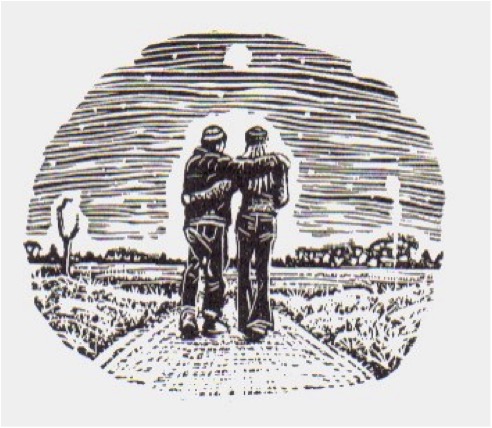
‘Sweet Dream’
Can you explain the figure often seen on your roofs?
As a kid in the Wimmera I used to spend a lot of time sitting up a tree or on top of our roof, dreaming (I like to imagine) of escape. Also maybe it’s the Launchpad for flight.
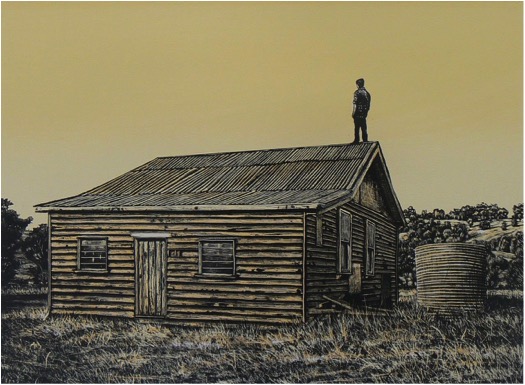
‘Lonely Boy 111’
You have your work in many Galleries. Did you introduce yourself or did they approach you?
A bit of both. I was very lucky early on and galleries approached me. I’ve actually approached some galleries recently and met with rejection, it doesn’t always work out and it’s a very tough game. Also it will be harder for me now as most commercial galleries aren’t interested in taking on a printmaker. I have a couple of commercial galleries I’m with, one in Canberra, Sydney, Hong Kong and London. Port Jackson press in Melbourne sell my work and I have it spread around a fair few regional print galleries.
I’m freelancing a bit more now, most commercial galleries want you to be exclusive to them in that city and many now I find are getting worse at actually paying you and you get pretty sick of forever hassling galleries to pay you your 60%
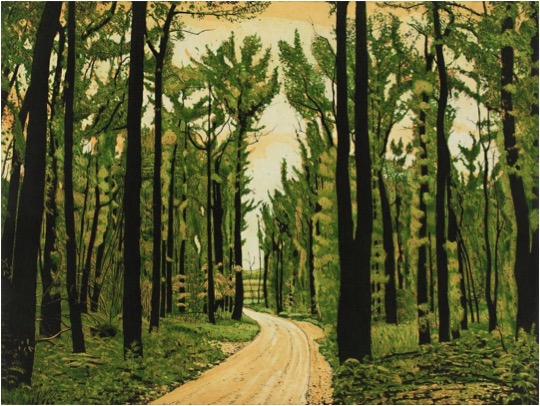
‘New Life’
Explain the importance of entering acquisitive and award winning exhibitions?
I admit I’m pretty competitive so prizes have that attraction for me. It’s a lot of work though and it means bugger all really. You do get your work seen though and often it helps you to get into collections if you get acquired.
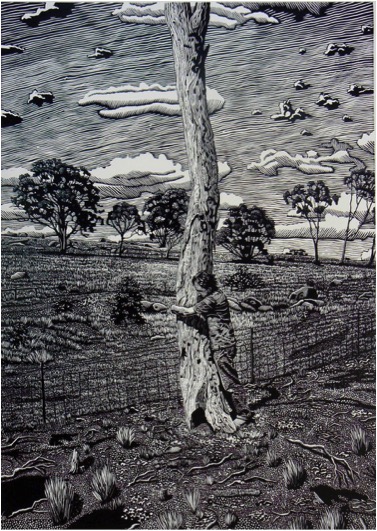
‘Holding On’
Can you discuss your iconic caravans and how the first appeared and why?
There’s several things I love about caravans. One we had one as a kid and we used to have many a happy holiday in it. Also it’s such a loaded image, you can make them ambiguous, like is it for a holiday or is it a home? It creates that tension I love, like is it happy or sad, safe or menacing? They are also so humble. As well as those things they are great shapes with great colours!
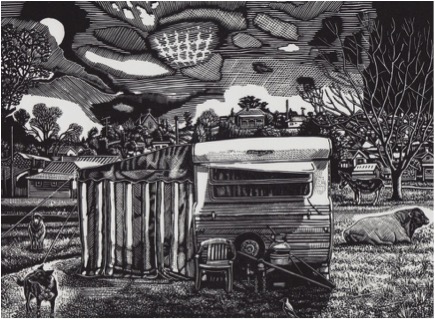
‘Lost’
Discuss your work ‘Lest We Forget’. Are we likely to see a similar theme as we had on the 100 year anniversary of WW1 and our current involvement in war zones?
That image happened by accident. In 2007 the ABC (Australian Broadcasting Commission) did a doco on me as part of the artist at work series. In mine I went back to my old home town of Murtoa and go over my old haunts and make some art from it. It just happened to be Anzac day and so we filmed the formalities and the march. I loved the character of the old digger who led it and I knew it would make a great image. I intended the image to mean not just lest we forget the diggers but the old days and the old ways, the old dying towns, the old climate. It was a very moving experience. A couple of years ago that old digger actually died on Anzac day.
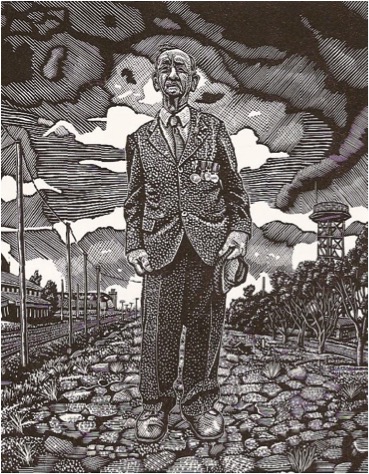
‘Lest We Forget’
Humour plays a large part in your work. Please discuss?
Humour makes sadness much more powerful and accessible. I do a lot of images now on hopelessly confused and bewildered men. It’s a fertile subject, one I find sad yet also funny.
You are currently building a new home in rural Victoria, Australia. Will it include a studio? If so, what are a few of the must haves? If not, where is your studio and why do you choose not to work from home?
I’ve lived up here in Castlemaine for nearly 7 years. I was very lucky to be able to buy a relatively cheap double block with an old converted stables on it. I built a studio up one end and last year I sub-divided the place and sold the old stables. I made a bit on it and am now nearly finished building a new house. The studio is a big tin shed with a mezzanine and I’m a very lucky man. Its good working at home but the danger is that daily life issues can distract you.
I am fascinated with the daily timeline of artists, what would be a typical working day or week for your in the studio?
I try to be disciplined. I usually get into the studio by 9 and try to work a full day. I have young kids though half the week and have to do school pickups and shopping and cooking etc. My plate is pretty full! Every second weekend I have the chance to do some work too. I’m not very good at working at night. I usually just crash out in front of the telly and go to bed pretty early.
You also find time to teach. How and where are these classes held? Are you open to offers to teach in Australia or overseas?
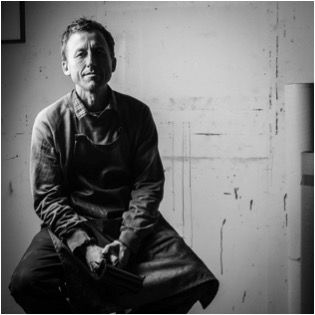 I have run lots of workshops in recent years, mostly wood engraving but sometimes linocutting and etching. I do one or two a year in my own studio and often at other peoples. I’ve done them all over Victoria and sometimes interstate. Sometimes in Sydney and Adelaide. It’s usually fun and a good way to supplement my income. I have a little press I can take in my car which means I can do a workshop anywhere (and I am happy to consider offers).
I have run lots of workshops in recent years, mostly wood engraving but sometimes linocutting and etching. I do one or two a year in my own studio and often at other peoples. I’ve done them all over Victoria and sometimes interstate. Sometimes in Sydney and Adelaide. It’s usually fun and a good way to supplement my income. I have a little press I can take in my car which means I can do a workshop anywhere (and I am happy to consider offers).
Contact details
defraz1@bigpond.com
www.dfrazer.com
David Frazer, Victoria, Australia
Interview by Deborah Blakeley, November, 2014
Think a colleague or friend could benefit from this interview?
Knowledge is one of the biggest assets in any business. So why not forward this on to your friends and colleagues so they too can start taking advantage of the insightful information the artist has given?
Other artists you may be interested in:


